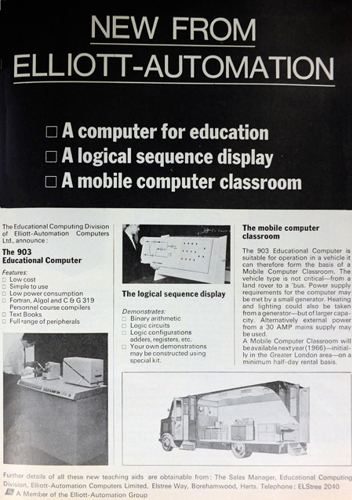The 1960s began with Muhammad Ali winning the light heavyweight gold medal at the Summer Olympics and, later in the same year, Sputnik 5 was launched. The latter carried two dogs, 40 mice and two rats.
1961 saw the launch of the Ford Capri and, some months later, Yuri Gagarin was blasted into space by the Russians. The decade closed with the Nixon’s inauguration as the 27th president of the United States, the Beatles releasing Yellow Submarine and, on the other side of the world, the Vietnam war raged.
The 1960s was a tumultuous decade that saw huge shifts in technology too. The first Laser was built, Philips release the cassette tape and, in 1966, Sony released the Trinitron.
Here are some classic computer adverts from the 1960s that capture the decade’s mood and key IT innovations. The adverts all appeared in issues of Computer Bulletin, BCS’ members magazine.
1. EMI and its radar
Electric and Musical Industries, often know as EMI Records, EMI Music or simply EMI was a cornerstone of the record industry. During the war and the post-war years - and well before EMI’s spat with the Sex Pistols - EMI was however a pioneer in the RADAR technology. This advert explains how British European Airways, British Airway’s antecedent, bought a new and highly advanced EMIDEC 110 - a machine that could keep pace with data flows in the new jet age.

2. IBM slashes business reaction time
Email, WhatsApp and Twitter. Today the only limiting factor on the speed of communication is how fast we can type. Back in the sixties however data moved at a more pedestrian speed. Keen to chivy things along, IBM launched its Tele-Processing system. An intranet like system, it promised to make information glide around global organisational arteries as smoothly as signals do through the body’s nervous system.

3. Save money with Monroe
The Monroebot was a general purpose computer built by the Monroe Calculating Machine Division of the defence firm Litton Industries. This Monroe certainly had nothing to do with Norma Jeane Mortenson. The machine advertised here was no bigger than your secretary’s desk and was simple to use. It was also, apparently, incredible value for money. It cost £12,500 in 1962. In today’s money that’s around £245,000 or about the same prices of the average house in the UK, at the time of writing.
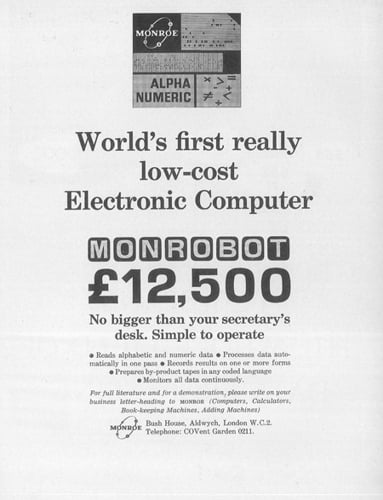
4. LEO Lector is fast
The English Electric-Leo Lector had a trick up its sleeve and it was nothing to do fava beans and nice chianti. Rather more prosaically, the Lector could read hand marked documents and turn them into data. The machine had catholic tastes - it accepted documents marked with pen, pencil or even ball point. Data could be ingested at between 120,000 and 200,000 characters per hour. Adding further attractiveness, if a document couldn’t be read, it was rejected. Automatically.
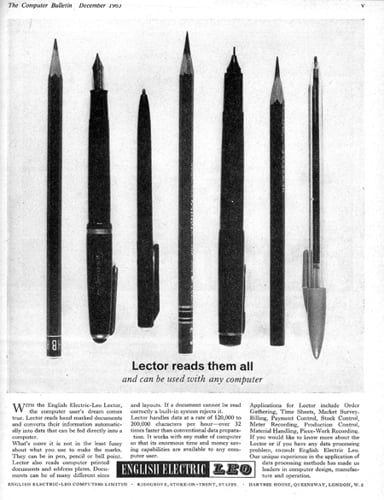
5. A dusty disaster
What kept computer centre managers awake at night during the 60s? Worries about the march of communism? The nuclear arms race? The neighbours playing the Stones too loudly? Possibly. More realistically though the bane of a computer operator’s life was a basic evil: dust. Happily the British Vacuum Cleaner & Engineering Company of Leatherhead, Surrey had the answer. Social historians should note that men operated the computer while women appeared to manage the vacuuming.
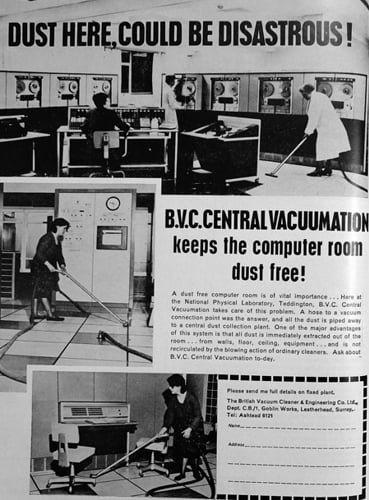
6. I.C.T punched card system
Today we take cloud storage for granted and think nothing of storing 128GB of photographs on micro-SD card. Back in the 1960s though, things were very different. International Computers and Tabulators Limited was a leading light in the field of punched cards, shown here advertising its innovative 40 column inch card - a system that could mechanise sales, accounts, stock control and more.
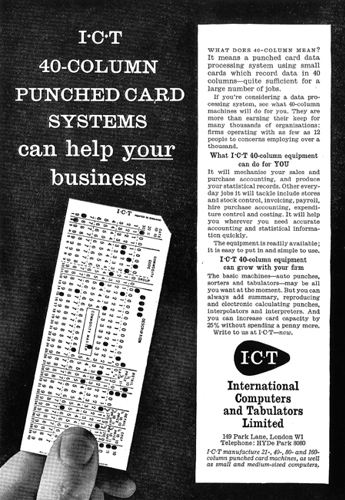
7. A new computer can be painful
Today, when you buy a PC or a phone, your existing apps generally work on your new piece of hardware and they do so more quickly. Back in the freerolling sixties interoperability and standards weren’t such commonplace requirements. Indeed, upgrading to a new computer could carry a real sting. Honeywell’s Liberator might sound like something from Blakes 7 and, in a way, it was just as futuristic. The Liberator could let you convert your old IBM 1401 programs so they would work on a new Honeywell Series 200 machine. Automatically, permanently, painlessly. No reprogramming. No retraining.
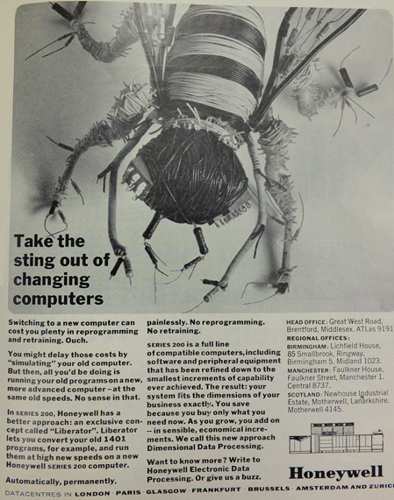
8. IBM disk pack
A disk pack was a layered group of disk platters that were coated in a magnetic storage surface. It was the core component of a hard disk drive - very much the precursor of today’s ubiquitous drives. There are key differences though. Firstly, in a modern drive the disks are an integral part that can’t be removed. In IBM’s original system, the pack of platters could be removed with a lifting handle. By today’s standards the IBM disk pack was also very big. The disks had 356mm platters. Inserting a new disk pack wasn’t the work of moments either. Though exchangeable the disk cartridges and the drive’s read and right heads needed aligning. This involved patience, special tools and, initially, an oscilloscope.
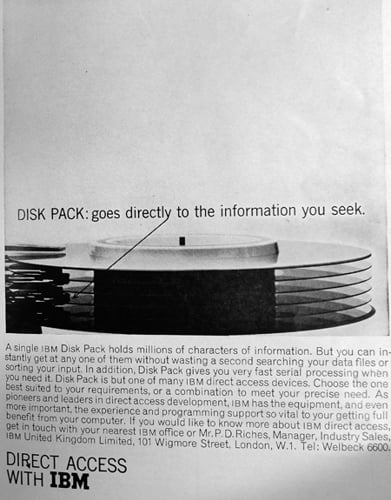
9. Decimalisation with Olivetti
Start now and it’ll cost you less. That was Olivetti’s warning to business worried about the operational effects of moving to the promised new decimal system. The Olivetti system would work in £ s d before 1971, in both systems during the change-over period and then, finally, in the new decimal currency alone. British Olivetti also offered firms a free survey of their accounting departments and practices. Without conversion or modification, the system would handle every aspect of the future special British decimal currency, including the new ha’penny.
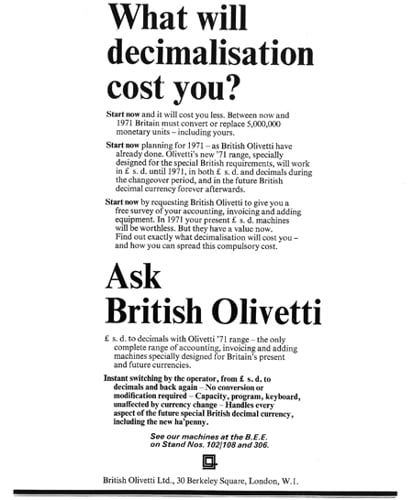
10. Low cost data transmission
The internet’s ubiquity makes it easy to forget that transferring files from one machine to another used to be a painful and slow process. The Marconidata H6010 was a step towards fast large area networking. Using telephone circuits, the system could transfer data at 600-1200 bauds. That converts to between 75 and 150 bytes per second. Along with being described as fast, the machine was also small - being only cabinet sized. It was also safe and silent. The machine would work on public telephone lines, leased lines and over any distance. All from an English Electric Company.
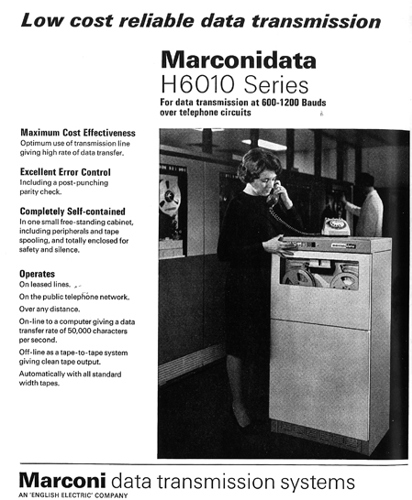
11. The mobile classroom
The uptake in the use of computers in industry saw many, the British Computer Society included, debate the rising skills shortage. In 1965 however, Elliott Automation launched the 903 Educational Computer. Thanks to its low cost, simple operation and low power consumption it could be mounted in a vehicle and driven around. Anything from a Land Rover to a bus would be enough to move the machine. The system could teach Fortran, Algol and C &G 319, binary arithmetic, logic and lots more.
